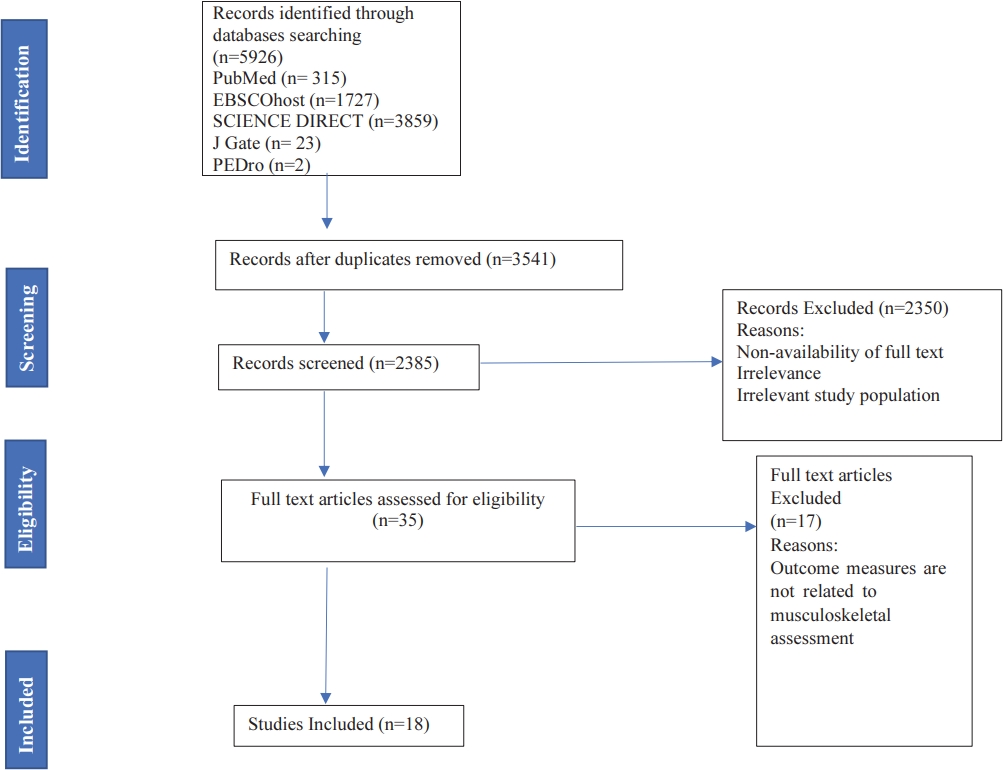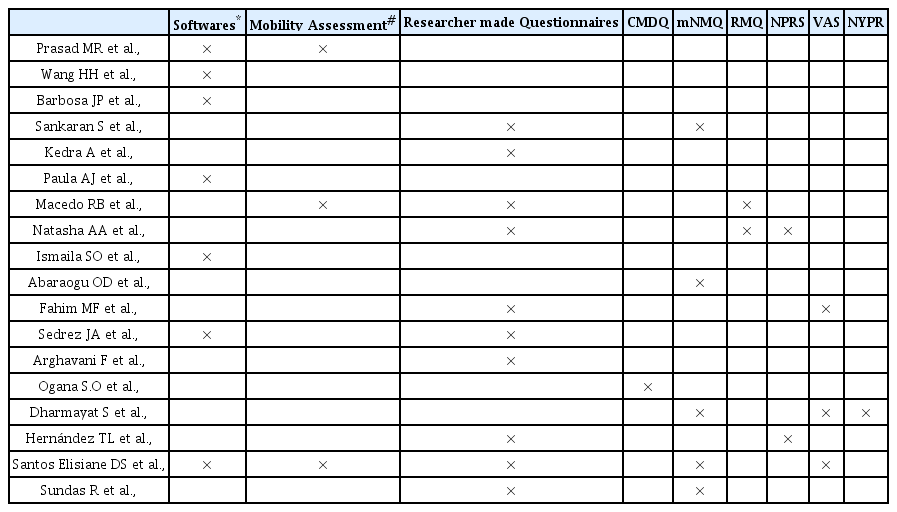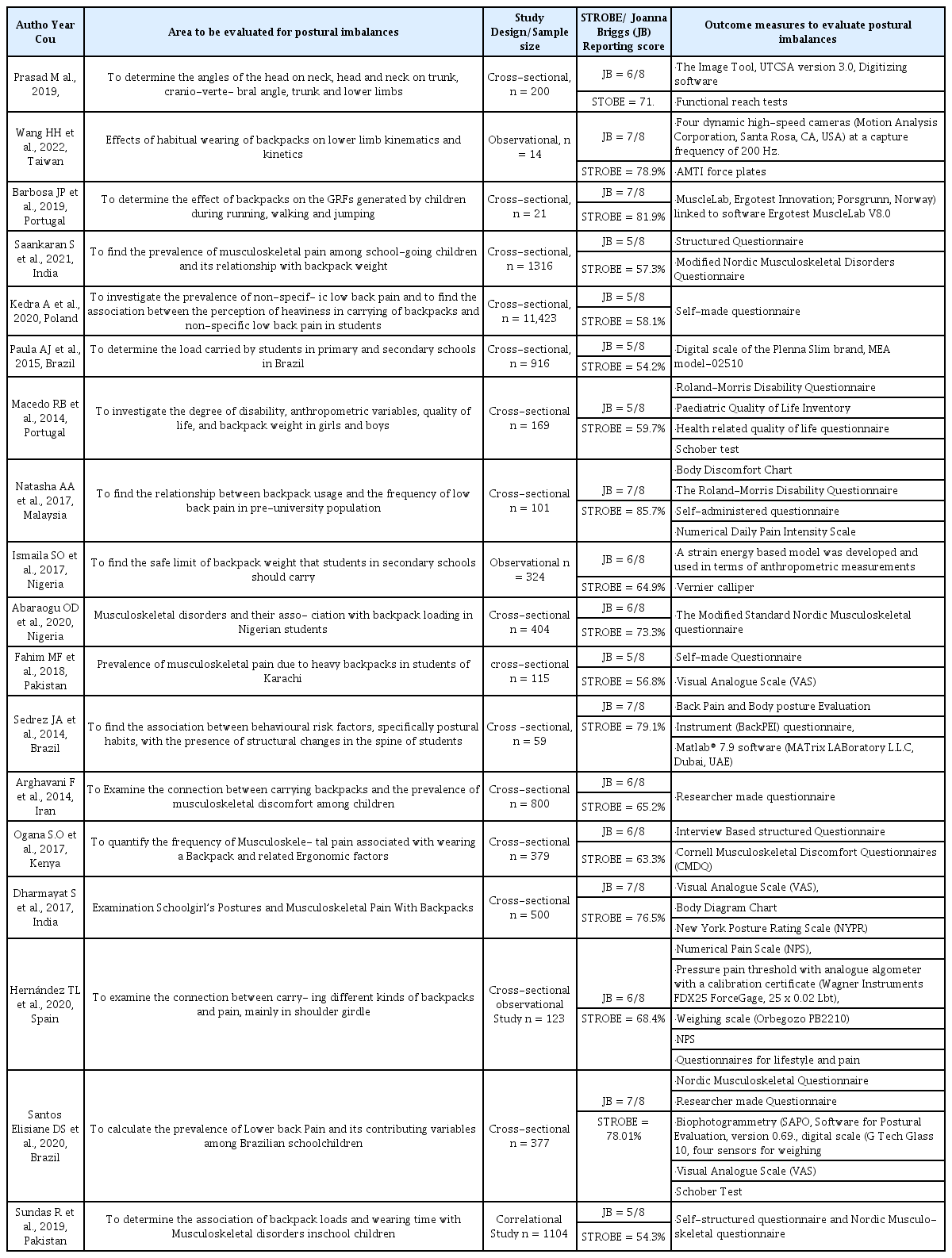Analytical parameters to check association between load carriage system and bag packs-influenced musculoskeletal complications among school going students: a scoping review
Article information
Abstract
[Purpose]
This study aimed to investigate the correlation between load-carriage systems and backpacks on musculoskeletal complications among school-going students. Additionally, the purpose was to identify research gaps and provide recommendations for future research.
[Methods]
To conduct this study, we conducted a thorough search of five databases for literature published between January 2010 and December 2022. Our focus was on original published articles that reported musculoskeletal complications using analytical parameters or outcome measures among school-going students. Two reviewers independently extracted data for eligibility. The studies selected for the analysis focused on musculoskeletal complications and the outcome measures to report these complications.
[Results]
A total of 3541 titles were screened; of which, 18 observational studies were included. The musculoskeletal complications identified in these studies included lower back, shoulder, and neck pain and disturbed posture. Overall, the quality of the reporting in these studies was deemed satisfactory.
[Conclusion]
Our analysis revealed that pain and postural abnormalities were the most frequently reported complications. Hence, we recommend that future studies incorporate multiple evaluations rather than concentrating on a single symptom.
INTRODUCTION
The use of heavy bags is frequently investigated in context of structural issues of the body, specifically the musculature of the neck and back, owing to the necessity of transporting essential materials for educational purposes [1]. Growth phase in juveniles is characterized by rapid growth and development of spinal structures, soft tissues, and bones. Furthermore, external forces such as the weight of a bag impact the overall growth phase in relation to posture and gait, rendering school-going students more predisposed to disruptions in the musculature of the neck and back [2]. The Chiropractic Association of the United States declared that backpack designs should be limited to accommodating hardly 10-20% of an individual’s body weight, a standard that aligns with the majority of guidelines [3]. A backpack is essentially a container that is carried on the back of an individual and anchored by two straps that extend vertically across the shoulder [4]. Numerous countries have established guidelines to mitigate the adverse effects of the cumulative weight of a student’s belongings on their back, which could give rise to backpack syndrome. Backpack syndrome is characterized by the discomfort that arises from carrying school or college supplies that weigh 10-40% of an individual’s weight in a bag that weighs anywhere from 4.5 to 18 kg. Moreover, the repetitive carrying of such a load, particularly in a static posture, impairs the blood flow. This may lead to the accumulation of lactic acid, which causes skeletal muscle fatigue and, resulting in muscle pain [5].
Within the human body, the presence of muscular imbalances can produce certain effects [6]. Specifically, the scapulae and neck may be affected, particularly in individuals carrying heavy backpacks. The upper anterior and posterior muscles located in the neck, classified as tonic muscles, may shorten, resulting in postural alterations and imbalance. Conversely, the deep posterior muscles within the neck and lower posterior muscles in the scapulae, classified as phasic muscles, may become restrained, stretched, or weakened. This anomaly affects between 11% and 60% of individuals of diverse age groups and societies [7].
Recent studies have indicated that backpack load capacity is a risk factor for the onset of back pain in children and adolescents that can persist into adulthood. In a study conducted by Ramprasad et al., school backpacks weighing 5, 10, 15, 20, and 25% of Indian students’ body mass were reported to cause postural changes. The results showed that carrying a backpack with a load equivalent to 15% of one’s body weight leads to significant alterations in the head, neck, trunk, and lower limb angles, ultimately resulting in adverse impacts on posture [8]. Nobles et al. recommended specific corrective posture exercises to improve the physical development of children. Failure to engage in regular physical activity leads to irregularity and unhealthy self-perception [9]. Activities such as dance, yoga, and sports, which are part of movement education, have a positive effect on balance and body image [10]. The overall status of musculoskeletal system usually influenced by heavy bag packs remains to be concerned. There are no targeted interventions because specific complications caused by musculoskeletal involvement in students have not been identified. Future physical function interventions for students may benefit from identifying the postural issues caused by carrying heavy bag packs. However, the outcomes used to assess postural imbalances in students and the types and severities of musculoskeletal complications caused by carrying heavy bag packs remain unclear. The purpose of this review was to examine the various analytical parameters and outcome measures used to assess the association between the load carriage system and bag pack-influenced musculoskeletal complications. Our research question was as follows: What is the extent of the original research identifying the usage of outcome measures to analyze musculoskeletal complications among students who use heavy bag packs?
METHODS
The methodology by Arksey, O’Malley [11], and Levac et al. [12] was used to conduct this scoping review which was reported with the help of the Preferred Reporting Items for Systematic Reviews and Meta-Analyses extension for Scoping Reviews (PRISMA-ScR). The major concern of this methodology was to rapidly map the research questions, problems, main types and sources of available evidence. We consulted a health research librarian, identified the relevant databases, and devised a search strategy. For this scoping review, the following databases were searched for articles published from January 2012 to December 2022 (10 years): PUBMED, J Gate, SCIENCE DIRECT, the Physiotherapy Evidence Database (PEDro), and EBSCOHost.
Inclusion/Exclusion criteria
We included the following: population: school-going students, aged between 10 and 20 years, carrying heavy bag packs; concept: outcome measures to analyze the association between load carriage system and bag pack-influenced musculoskeletal complications among students. Context: retrospective and prospective studies (qualitative and quantitative research).
Based on our research question, we excluded all studies based on any other assessment approach unrelated to musculoskeletal complications. Abstracts on case studies, case series, newspaper proceedings, and conference proceedings were excluded. Non-English language studies were excluded to enhance the pragmatic approach.
All titles and abstracts were evaluated by one reviewer (MG), and any notable omissions were removed. Two reviewers (MG and SS) independently evaluated the full-text articles selected for inclusion, and a third reviewer (AK) was available in the event of a disagreement.
Data collection and analysis
Data were extracted based on the characteristics of the study (author, year, country, study design, study population evaluation area, sample size, and outcome measures). The quality of a study was independently assessed by two reviewers (MG and AK). The reporting guidelines used for assessment were the Strengthening the Reporting of Observational Studies in Epidemiology (STROBE), Standards for Reporting Qualitative Research: A Synthesis of Recommendations (SRQR), Joanna Briggs Critical Appraisal tool, and Consolidated Standards of Reporting Trials (CONSORT) guidelines. The percentage of reported items was found determined on the pertinent guidelines. According to this guideline, the proportion of reported items from the relevant guideline divided by the total number of items in the guideline minus the items not relevant to the research was used to determine the level of reporting completion of each study. The report was rated as follows: 70% acceptable, 51-69% moderate and 50% poor.
RESULTS
In this scoping review, 3541 potential articles were identified using the search engines mentioned in the methodology section. Eighteen quantitative studies met the selection criteria as described in the PRISMA-ScR study flow diagram (Figure 1). Non-availability of the full text, inclusion of musculoskeletal assessment based outcome measure and irrelevance were the common reasons for exclusion. The characteristics of 18 observational studies are presented in Table 1. Most studies included school population as one of the major eligibility criteria. The studies were conducted in India (n = 3) [13-15], Brazil (n = 3) [16-18], Nigeria (n = 2) [19,20], Portugal (n = 2) [21,22], Pakistan (n = 2) [23,24], Taiwan (n = 1) [25,26], Poland (n = 1) [27], Spain (n = 2) [28,29], and Kenya (n = 1) [30]. Six studies evaluated musculoskeletal pain. There was an evaluation of the posture (n = 5) [13,17,21,23,30], and behavioral changes (n = 1) [27], however the majority of studies included physical and anthropometric assessments (n = 15). The outcome measures varied significantly, as summarized in Table 2.

. Flow diagram of Preferred Reporting Items for Systematic Reviews and Met-Analyses extension for Scoping Reviews (PRISMA-Scr).
Quality of reporting
According to the evaluation against STROBE, the majority of the studies were rated as satisfactory (median score, 61%, IQR 54 - 86), with a consistently well-reported musculoskeletal assessment. The sample size and relationship between backpack-associated musculoskeletal complications and quality of life have been reported to be poor.
DISCUSSION
This scoping review evaluated the analytical parameters to examine the possible association between load-carriage systems and musculoskeletal complications influenced by backpacks among students. The primary emphasis of this review pertains to the outcome measures used to evaluate musculoskeletal complications among the school-going population and the quality of reporting. Eighteen studies were assessed and revealed a high prevalence of musculoskeletal complications influenced by load-carriage systems across a range of diverse outcome measures. The uncertain nature of the association between musculoskeletal complications and load-carriage systems is due to inadequate reporting in previous studies and a lack of randomized clinical trials.
The evaluation of study reporting was conducted in accordance with the STROBE guidelines. As all studies were observational in nature, their overall adequacy was assessed, resulting in a mean score of 68.1%. However, it should be noted that there was a wide range of reporting scores, ranging from 54-86%. This variation highlights the potential for future improvements in such examinations, particularly in relation to sample size calculations and analysis of the relationship between musculoskeletal complications and load-carriage systems with regard to quality of life. A more comprehensive assessment of the long-term impact of musculoskeletal difficulties on school-going populations using backpacks as well as their capacity to participate in everyday activities is warranted. Further refinement in this area is necessary to provide insights for future research.
Utilizing more dependable analytical parameters to evaluate musculoskeletal complications caused by backpacks would be beneficial for treatment enhancement. The assessment of outcome measures for musculoskeletal complications differed significantly among studies, with 14 distinct measures employed, including 6 measures that focused on analyzing postural disturbances when carrying backpacks. Self-administered questionnaires created by the researchers, were the most frequently used outcome measures. However, the content validity of these questionnaires has not been mentioned in any single study, making them less feasible. Modified Nordic Musculoskeletal Questionnaire (mNMQ) has been used in several studies (n = 5) [14,16,17,20,24] and permits the comparison of lower back, shoulder, and neck-related musculoskeletal complications in epidemiological studies. Nevertheless, this tool is not specifically intended for clinical decision making and is not directly related to backpack-influenced musculoskeletal complications. Six studies [17,19,22,23,25,28] used various analytical software packages to assess potential postural irregularities influenced by backpack usage. One study formulated a model based on strain energy, incorporating the chest width, chest depth, Young’s modulus of elasticity of articular cartilage, maximum allowable spinal shrinkage, spinal length, and student height to determine the appropriate backpack weight for school-going individuals. The findings of this study suggest that male and female students should avoid carrying backpacks exceeding 2.87 kg (5.18% of their body weight) or 2.53 kg (4.91% of their body weight), respectively [19].
This review examined and reported several long-term complications resulting from carrying backpacks. These include the angles of the head, neck, and trunk [13], the impact of habitual backpack use on lower limb kinematics and kinetics [25], and the effects of backpacks on ground reaction forces (GRFs) during running, walking, and jumping [22]. Additionally, studies conducted among school-going populations have documented behavioral changes associated with backpack use. Interestingly, the association between pain and backpack carrying was the most frequently and comprehensively evaluated area among the studies reviewed studies. However, notably only 5 studies have used the numeric pain rating scale (NPRS) and visual analogue scale (VAS) as primary outcome measures to examine the correlation between backpacks and pain. The predominant area of pain reported was the lumbar region, or the lower back area, which was also assessed via range of motion evaluation using the Schober test, lumbar extension test, and Cobb’s angle. However it is important to note that the evaluation of the upper extremities is relatively minimal compared with that of the lower extremities, with only three studies incorporating the assessment of the shoulder and neck regions.
The literature we examined demonstrated that musculoskeletal issues represent an increasing risk factor for longterm physical disability among students who use backpacks. There are numerous opportunities for further exploration, necessitating transparent sample size estimates and inquiries into the correlation between musculoskeletal issues and the quality of life or function. Future studies should incorporate a comprehensive series of evaluations of multiple musculoskeletal heath factors, rather than focusing on a particular issue such as posture or pain. These findings are consistent with those recommended by other musculoskeletal services including musculoskeletal patient-provided indicators and performance metrics. Given that the shoulder, neck, and trunk are the most commonly affected regions, further investigation is warranted in cases where a sufficient review has not been conducted. Examining the correlation between cardiopulmonary fitness and musculoskeletal impairment may guide the selection of rehabilitation outcomes for individuals experiencing backpack-related musculoskeletal challenges. Ultimately, a more profound understanding of these musculoskeletal complications, encompassing their clinical course, may facilitate the development of workable solutions for populations affected by backpacks.
This appraisal may not accurately represent musculoskeletal issues that have been reported in languages other than English, as non-English language papers were excluded. Although gray literature, such as conference abstracts, was also omitted, it is unlikely that they would include the necessary data for research assessment owing to word length restrictions. This review had several notable advantages. We conducted a comprehensive search of studies published between January 2012 and December 2022 five electronic databases, and examined a wide range of studies that covering all aspects of musculoskeletal issues among students. Furthermore, to facilitate reviewer concurrence, we established a robust methodology and evaluation that considers STROBE reporting criteria.
Our review aimed to assess the breadth of studies in this area because musculoskeletal complications are a field of possible impairment that is receiving increasing attention. We discovered a diverse corpus of musculoskeletal complications is reported to be quite common in the literature, employing a range of outcome measures across a variable timeframe. Future studies should use a comprehensive approach or assessment that considers both the upper and lower limbs. There should be unambiguous documentation of sample size computations in research, as well as the function or quality of life and musculoskeletal complications.

